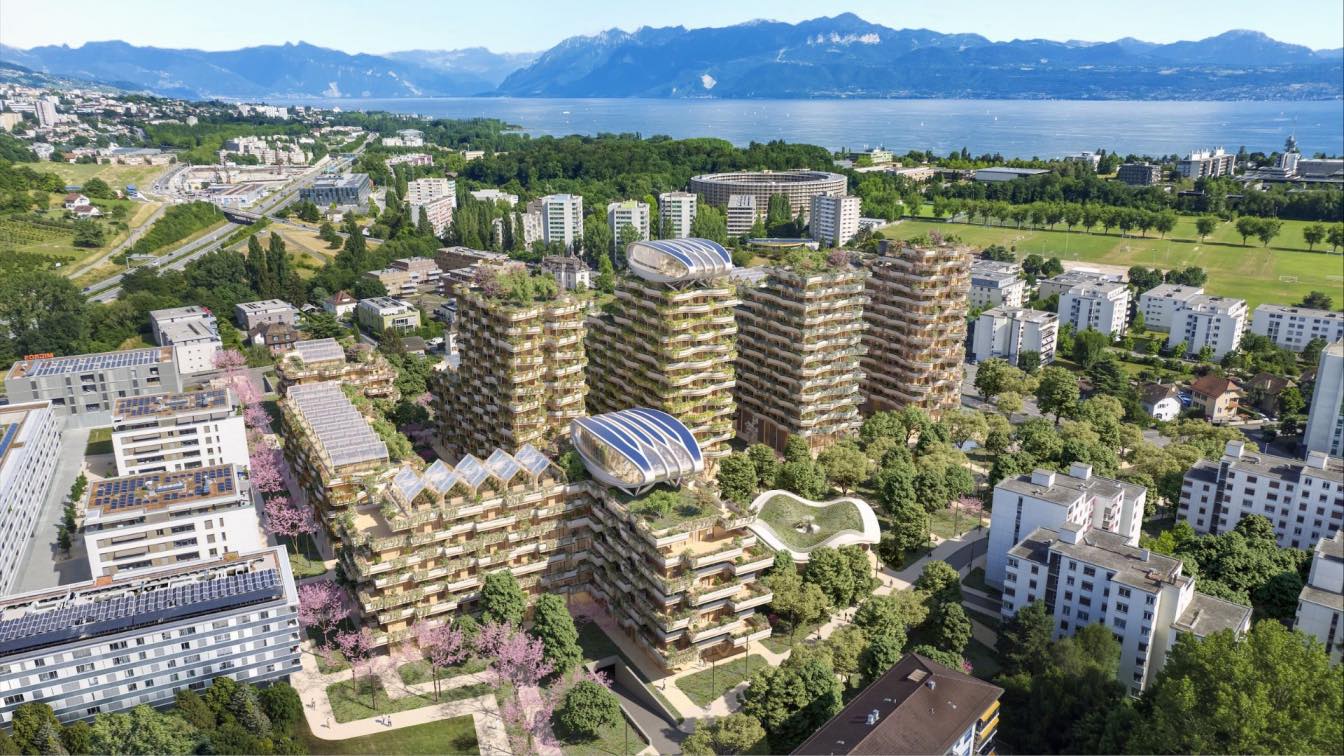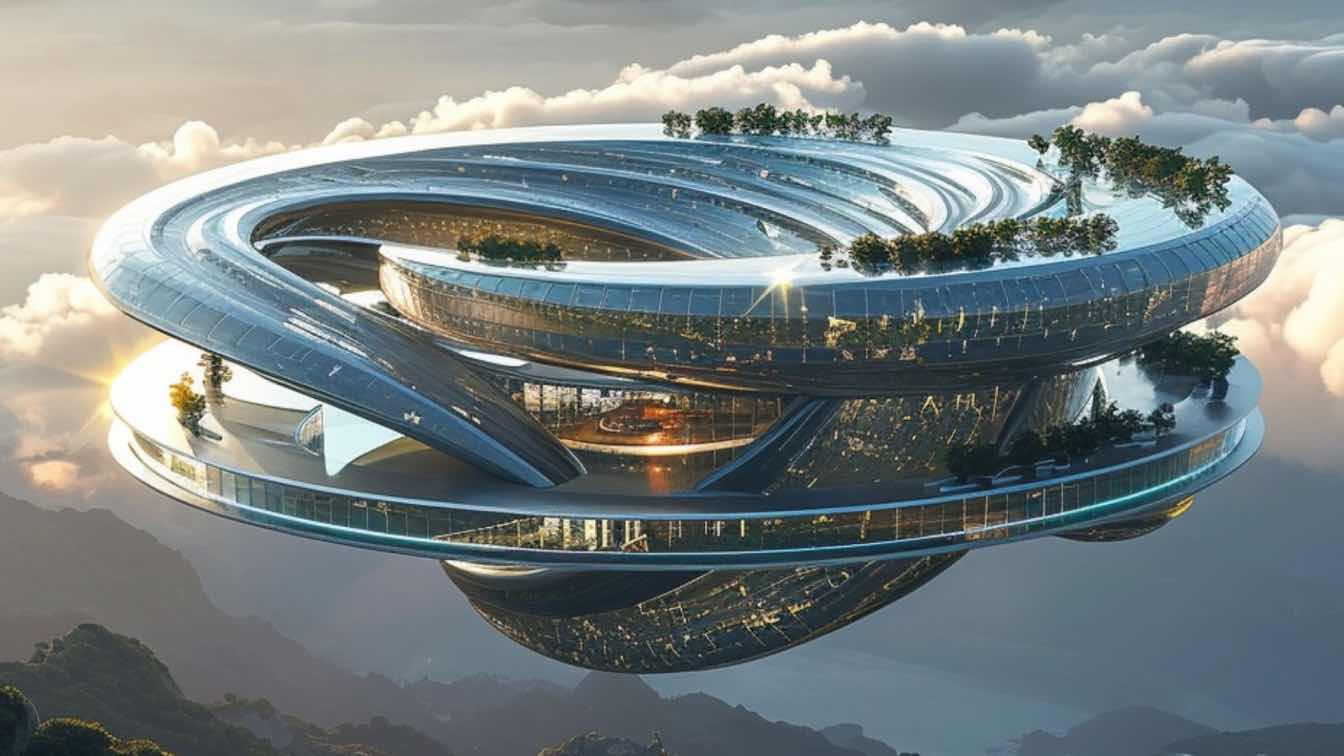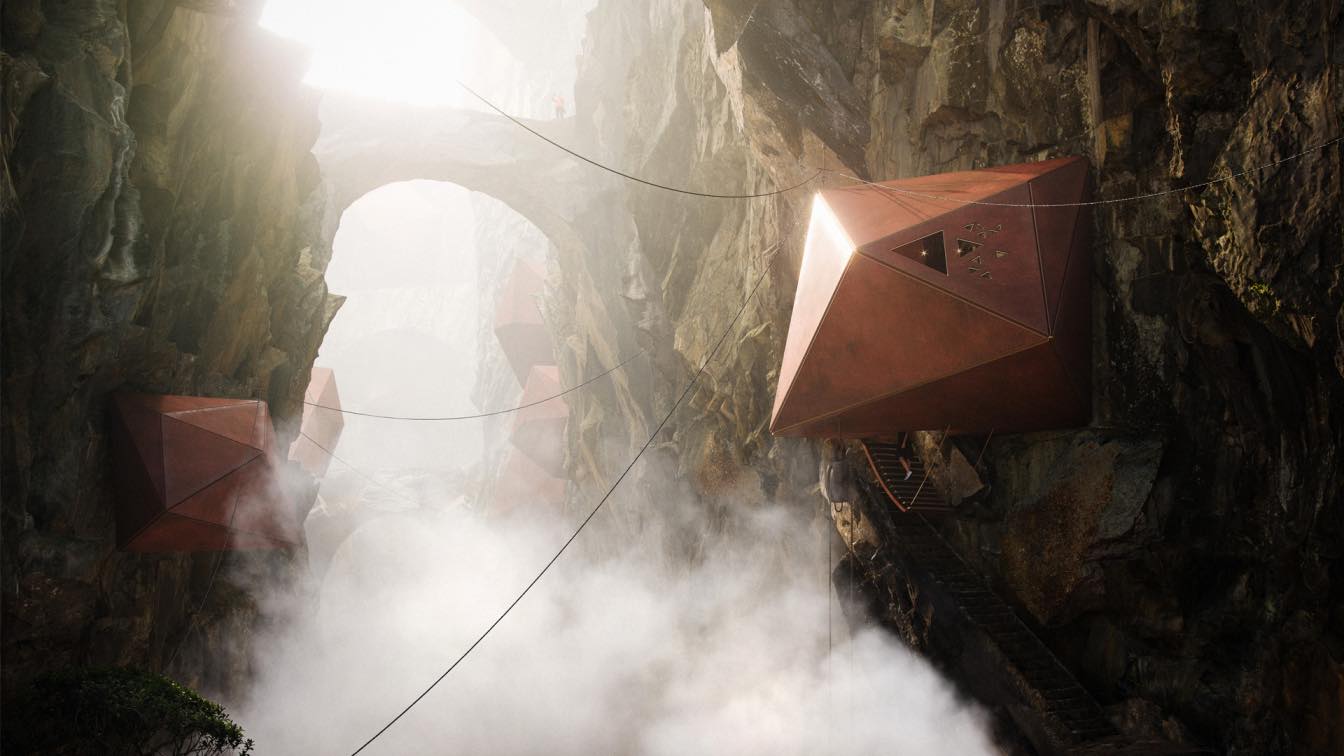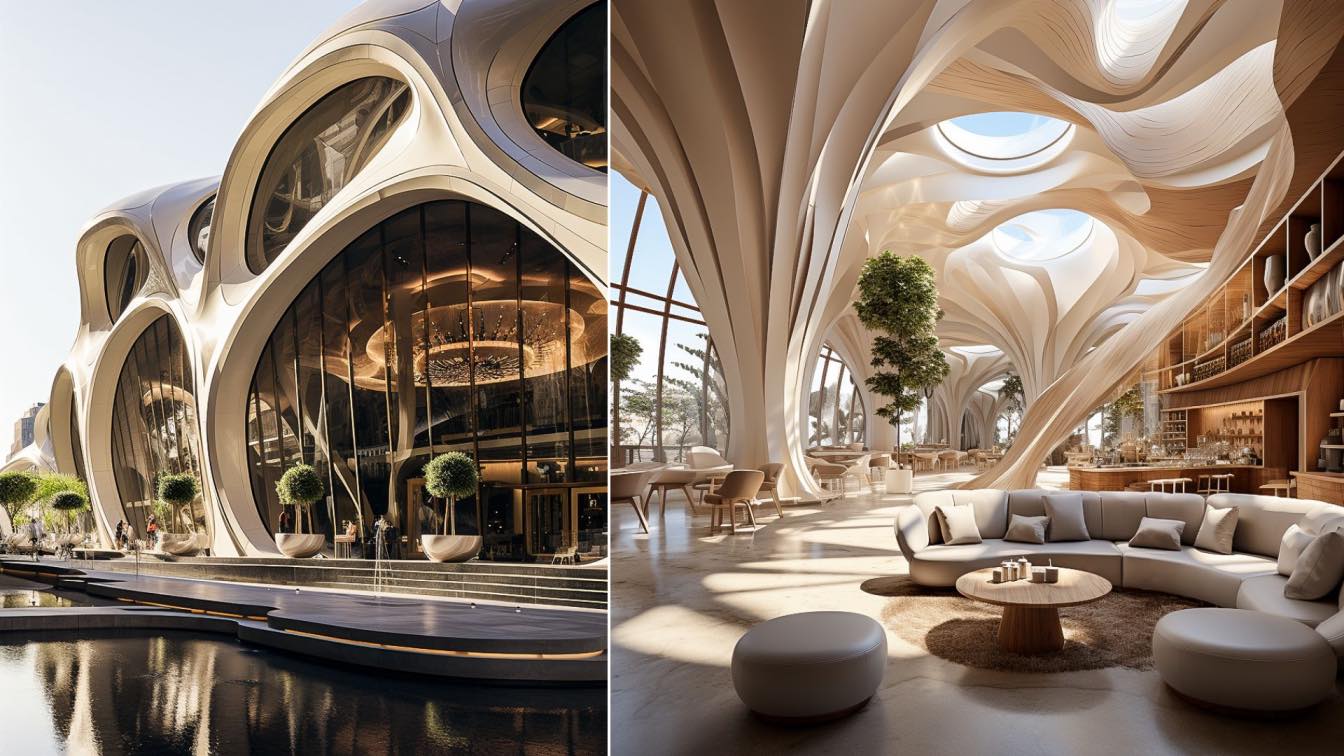Vincent Callebaut Architectures: Create A New Public Park That Polarizes A Pedestrian Eco-Neighborhood Densely Plant & Aquatic
In the heart of the Lake Geneva region, in the canton of Vaud, between the Chavannes-près-Renens train station and the Swiss Federal Institute of Technology in Lausanne, the “Old Greenhouses” site constitutes a new urban hub, a true Cardo-Decumanus . This involves integrating the project into territorial ecological and landscape continuities to create a link between Lake Geneva and Piedmont.
The ambition is to create a peaceful eco-district - without cars on the surface - by creating a large urban park in the open ground dedicated solely to pedestrians and cyclists where it is good to live and have fun in the heart of lush nature.
The identity of this eco-district therefore borrows from this new public park by densely planting it to reveal the Genius Loci of these Old Greenhouses which were historically dedicated to horticulture and thus reactivate the heritage of flower cultivation.
It is an immense island of urban freshness which benefits from the evapotranspiration of mature trees and ensures the retention of rainwater which is imagined. This type of park dominated by open land, extensive flowering meadows and major trees in the medium term, is also intended to be open to the city: from residential green space to public park.

Continuing the North-South mall of the “Quartier des Cèdres” where the 117 meter high “Cedar Tower” by Stefano Boeri will be located, the park widens out over one hectare towards the south to create a destination place welcoming public services offered shared with the surrounding urban fabric (children's nursery, coworking, bars, restaurants, workshops, etc.) while allowing the continuity of the North-South soft mobility between Renens station and the Swiss Federal Institute of Technology in Lausanne, the famous “EPFL”.
In the East-West axis, the landscaping plan is to revive the old “Traverse des Vergers” (The Orchard Crossing) which thus connects the cantonal road 82-B-P in the commune of Ecublens to the West and Avenue de la Gare on the commune of Chavannes-Près-Renens to the east. This crossing of fruit trees planted mainly with cherry trees alone recalls the City's coat of arms decorated with an arch and three cherries.
Water is also an essential component of the framework of this new park which is intended to be permeable. It is found in the form of a large valley along the North-South mall which flows into a panoramic body of water along the Route de la Maladière. Between the buildings, it takes the form of phyto-purification lagoons and basins dedicated to aquaponics, permaculture, and urban agriculture.
On the buildings, rain chains inspired by Feng Shui choreograph the gravity runoff of rainwater from the green roofs to the orchards in the ground via the landscaped balconies.
In addition to this retention of rainwater, there are osmotic pumps in the basement which also filter gray water coming from the kitchens and bathrooms of housing to ensure the supply of water in a virtuous loop for drip watering, water for cleaning and water for sanitary facilities.
Between the Chemin du Champ-Fleuri and the North-South pedestrian mall, we find - surrounded by mirrors of water - an architectural madness poetically named "Le Nénuphar" whose voluptuous curves welcome children into a new municipal children’s nursery in the heart of an enchanted landscape.
Finally, to optimize the planting areas in the open ground and the number of mature trees, the infrastructures dedicated to the planned parking lot are located almost exclusively under the footprint of the buildings and not between the buildings. The three access points to this car park are discreetly integrated to the west, rue du Champ-Fleuri, to the south along the route de la Maladière, and to the east, Avenue de la Gare.

Neither Tower, Nor Bar, Imagine Flourishing Sky-Villas To Sculpt The Views Towards The Jura, The Alps And Lake Geneva
The architectural bias was designed from the interior of the family unit towards the larger landscape.
Fighting against horizontal urban sprawl and land artificialization, the project integrates the rules of bioclimatism by respecting the path of the sun from East to West and the direction of the dominant winds coming from the South-West.
All the apartments are perfectly oriented like a comb systematically articulating the living areas towards the south and the lake, and the sleeping areas oriented towards the North.
100% of the apartments are facing south, crossing and multi-oriented to offer the best quality of living.
In addition, each of these apartments benefits from large panoramic balconies, allowing on the one hand to fully benefit from the exceptional views towards the Alps, Lake Geneva and the Jura, and on the other hand to provide the necessary shade to avoid overheating of living rooms.
These landscaped balconies are equipped with string planters allowing the cultivation of sustainable vegetation and providing domestic vegetable gardens as an extension of living rooms. This revegetation also makes it possible to bioclimatize the temperature felt by lowering it by 3 to 5 degrees thanks to the evapotranspiration of the plants while filtering solar radiation.

This housing concept is called “Sky Villas” and combines all the advantages of city apartments - close to services and culture - with the intimacy of an individual villa in the countryside with a private garden.
From the point of view of urban dimensions, the Greenhouses project proposes to offer a multiplicity of experiences by spreading the built volumes from the level 5 on the Avenue de la Gare side and its villas to the level 14 on the North-South pedestrian mall side of public park.
This ensures coherent development of urbanization through building volumes, spaces and circulation in harmony with neighboring neighborhoods.
The objective is to integrate as best as possible into existing heterogeneous buildings by proposing these hybrid geometries between the 105-meter-long bars of the Quartier des Cèdres and the Level+10 towers along the Route de la Maladière.
Neither tower nor bar, these stepped buildings present architectures with 1 step, 3 steps, 5 steps or even 10 steps opening a cone of perspective towards Lake Geneva from the cascading rooftops. This architecture, while progressively spreading, sculpts and magnifies the views towards the great landscape.
These cascades of duplex terraces and balconies installed in a staggered pattern make it possible to cultivate more than 30 000 plants and shrubs on these plant architectures which will capture 170 tons of CO2 in the atmosphere of Chavannes-Près-Renens annually to transform them into oxygen thanks to natural photosynthesis.
This is what we now call “carbon-absorbing” architecture or urban planning, labeled by the Low Carbon Building Alliance.
The eco-district, which is already low in intrinsic carbon, thanks to its bio-sourced construction materials, will therefore also be breathable and depolluting during its operation.
The concept of reasoned vertical greening proposes to assign to each building a specific color in the choice of plant species to create on the scale of the eco-district a rainbow gradient offering everyone the pride of living in their residence which is distinguished both by its shapes and its colors from the neighbor.
Diversity is created here in harmony.

Flexible And Scalable Buildings In Cross Laminated Timber (Clt), Constituting A Real Carbon Sink
The forest is inseparable from the Vaudois plateau and its capital Lausanne. It is subject to careful management by professionals who guarantee the environmental, economic and social sustainability of this ecosystem.
40% of the Canton of Vaud is covered with it and it extends into the heart of the city. The parks and estates service manages forest heritage as a vital resource to be preserved for future generations.
At a time when we need to find radical solutions to reduce our carbon footprint, and in a constant concern to put into practice the circular economy in a short and virtuous loop, the construction system proposed is the “Cross Laminated Timber”, named “CLT”.
Invented in the 1990s in Austria and Germany, this construction technique consists of superimposing strips of wood perpendicularly and connecting them together using now organic structural adhesives such as tannins, lignin, cellulose or even starch.
The CLT manufacturing process requires a much lower quantity of primary energy than that of concrete or steel, and it does not generate greenhouse gases. As a reminder, producing 1 ton of concrete generates 2.42 tons of CO2 and producing 1 ton of steel generates 0.938 tons of CO2 in the atmosphere.
In terms of fire resistance, remember that wood burns slowly, does not release toxic products, transmits heat 250 times slower than steel which melts, and 10 times slower than concrete which cracks under the effect. flames.
Built from trees cut and harvested in a short circuit in the heart of eco-responsible Swiss forests - where one cut tree is equal to one replanted tree - The Greenhouses project is therefore a real carbon sequestration sink. Indeed, during the growth of trees, the carbon stored by natural photosynthesis is found to be “trapped” in the solid wood and is therefore not released into the atmosphere. For one ton of wood produced, around 0.9 tons of carbon are sequestered. We are therefore talking about a building with a negative carbon footprint!
The global ecological label “PEFC©” (Program for the Endorsement of Forest Certification) guarantees the end consumer the traceability and reliability of certified products by establishing a chain of custody from the forest to the product finished on site.

From a structural point of view, the intersecting solid wood construction system offers a post-beam framework on a 5m40 grid with a height between finished levels of 3m20. This frame based on a subframe of 1m35 and 2m70 allows us to imagine an evolving architecture called reversible offices/housing or housing/offices. In fact, a 2m70 frame can accommodate a master bedroom as well as an individual office. It also corresponds to a parking space in the basement, including the thickness of the structure. A double frame of 2m70, or 5m40, ideally accommodates a spacious living room.
The geometric stacking of these modules measuring 5m40 on sides and 3m20 in height gives the appearance of inhabited hills to the new skyline of the Old Greenhouses. All these modules are constructed of solid wood, prefabricated and standardized off-site in the factory with a very high degree of precision. This construction system makes it possible to optimize construction time and ensure a clean site.
This design frees up space to allow each resident to personalize their apartment. In the sense of eco-sustainability, the possibility of being able to transform interior spaces as desired over time is the best guarantee of sustainable development and sustainability.
Wooden balconies also cover each building and their specific design gives each one a unique identity. Like the branches of a tree, they are designed – taking inspiration from the local biotope – in the shape of waves, mountain crests, strobiles, pinecones, or even battlements.
The overhangs of these landscaped balconies are taken up either by stay cables (for the “Les Cônes” building), or by consoles (for the “Les Créneaux” building), or quite simply by thin slender steel columns (for the buildings “Les Ondes”, “Les Strobiles”, “Les Roches”, or even “Les Tremplins”).
In elevation, the southern facades are adorned with blond wood, while the northern facades – more sensitive to humidity – are covered with burnt wood with silvery reflections called “Shu Sugi Ban”.
This wood also bears the name Yakisugi (焼杉板). Yakisugi is obtained by deeply burning the surface of wooden planks. This material is known to be more resistant to fire, wood-eating insects, and wood-eating fungi.
Burning gives the wood a heterogeneous structure which does not alter its structural capacity. Four layers are distinguished (going from the outside to the inside of the facade): carbon; tar; pyrolyzed wood; solid wood not affected by heat. Aesthetically, the buildings are thus dressed in a flaky color with a silver patina and bluish reflections.
The traditional Yakisugi technique aims for high environmental quality without any use of synthetic chemicals and without the use of ancillary energy sources, such as gas.
Burnt wood facades are inseparable from the Japanese aesthetic of Wabi-Sabi: the result of several natural processes - photosynthesis and fire - they acquire a patina over time, and this change in appearance is perceived positively by people who are confronted with it. Being in the Wabi-Sabi spirit means accepting the imperfect surface of the material that accompanies residents' lives.
Our leitmotif is therefore to combine functionality and elegance by enhancing natural, simple and traditional materials.
The Greenhouses Project is an architecture with a contemporary design born from a collective memory with refined curves tinged with a popular dimension, a collective ideal and an ancestral imagination.
He advocates the use and reinterpretation of endemic architectural and landscape styles.

Integrating Bioclimatism, Renewable Energy & Urban Agriculture To Establish Happy Frugality
After choosing solid wood construction to drastically reduce the carbon footprint of the entire project during its construction, our efforts focused on the integration of passive systems and renewable energies to reduce its carbon footprint during its operation.
First, the buildings benefit from external insulation - with natural materials - such as thatch, hemp, cellulose wadding or even wood wool coming from the ecosystem of local sawmills.
To ensure natural ventilation in each apartment, wind chimneys cross the vertical circulation cores over their entire height. These chimneys suck in outside air at 30 degrees in summer from the orchards planted on the ground floor. This hot air passes under the foundations where the thermal inertia of the earth is constant all year round at 18 degrees.
This naturally cooled air to 22 degrees is then blown into the apartments like in a termite mound. This represents an energy saving of 70% compared to traditional mechanical ventilation systems.
In addition, the layout of each building provides - for common sense - to place the stairwells and elevator shafts on the north facade so that they are naturally ventilated, lit and smoke-free.
In terms of Urban Agriculture, in addition to the vegetable containers planted on the balconies of the apartments, many standardized greenhouses, real small urban aquaponic farms or cultivated in permaculture, are established on the buildings "Les Tremplins", "Les Créneaux", “Les Arcs” and “Les Roches”.
A sustainable and virtuous farming technique, aquaponics combines fish breeding and plant cultivation and allows you to live in the city or in the countryside while maintaining social ties with your neighbors.

These sky farms produce up to 25 kilos of fruits and vegetables per square meter annually.
These foods are grown with 90% water savings, without chemical fertilizers or pesticides or GMOs but using natural fertilizer. Indeed, the fish feed the plants with nitrate, and in return the plants produce oxygen for the fish. The water thus purified then returns to the fish tank: the cycle can start again.
It is nothing less than a recreated natural mini-ecosystem, where the waste of one element becomes the food of another element. A “living market” will allow residents of the Greenhouses to stock up on farm products but also to taste them on site in a cozy atmosphere.
The greenhouses, naturally lit all year round, benefit from additional silicon cells integrated into the double glazing of the BIPV roofs to produce electricity for self-consumption.
The green roofs installed at the top of the tallest buildings integrate biodiversity gardens, veritable fifth facades allowing the development of ecological corridors favorable to diverse endemic fauna and flora.
Finally, a biomass boiler and a field of geothermal probes are designed to ensure the production of shared hot water at a reasonable price.
By 2050, 80% of the world's population will live in cities. We must now produce as close as possible to consumers and consume the minimum amount of resources while reducing greenhouse gas emissions.
As part of the new circular economy, The Greenhouses project is a prototype of a completely biosourced eco-district respecting the four pillars of the ecological city of the future, namely: energy self-sufficiency (heat, refrigeration and electricity); the greening of buildings and the development of urban agriculture; soft mobility focused on pedestrians, two wheels and electric co-mobility; social innovation through spaces for sharing between residents and solidarity services.






































































































